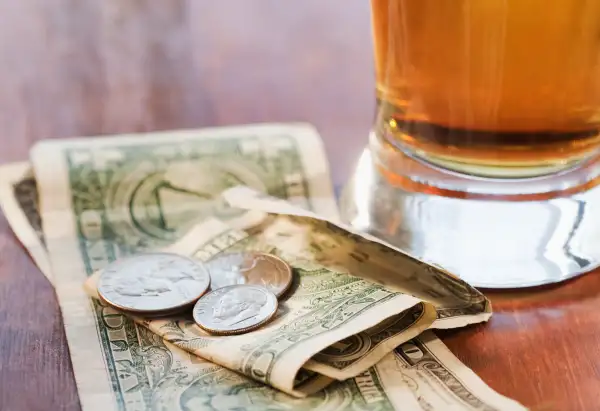This Money-Saving Trick Could Save You $1,758 a Year (or More)

If financial resolutions were easy, we wouldn't need to make them every year. But sure enough, each January people find themselves making two big promises: to save more and spend less.
This year, Money's staff decided to spend a month testing out a variety of money-saving tips and tricks. We picked a variety of strategies, from wallet hacks to digitally enabled habits to simple abstention. Some aimed at helping us spend less, and others were supposed to make it easier to accumulate savings.
Here's what we found: Change is hard. Only one of our three doing-without strategies paid off—the others either exacted surprise costs or imposed too great an inconvenience (or both). Assumptions can be another challenge: Those of us trying "wallet hacks" found them trickier than we'd thought, in part because we hadn't recognized quite how far we'd shifted to a cash-free existence.
In general, the most successful strategies were those that forced us to carve out a savings stash where none existed before. What follows is a full rundown of the strategies we tried, the total we saved with each, and a key takeaway.
The Success Stories
The most successful tricks were the ones that felt painless—at least in comparison to the money saved.
1. Matching bad habits with good
Total saved: $146.50
Estimated yearly savings: $1,758
How it worked: For every $1 that audience engagement editor Matt Bemer (@mattbemer) spent on alcohol in January, he matched it with $1 deposited into savings.
The results: Small, incremental moves helped Bemer put aside more money than the rest of the team. "I didn’t deposit $146.50 at the end of the month; I deposited $7, $8 here and there. Those micro-transactions felt less painful."
2. Automating savings
Total saved: $100
Estimated yearly savings: $1,200
How it worked: Editor-at-large Penelope Wang (@PennyWriter) set up a new dedicated savings account with transfers of $25 a week into it.
The results: Simplicity and ease-of-use proved key. The idea was to make the transfers automatic, but setup on Wang's first-choice account was more complicated than expected. As a result, Wang wound up making manual transfers to a different account—one that paid virtually no interest. And one week she forgot to make the transfer altogether, although she caught up the following week.
3. Setting aside every $5 bill
Total saved: $75
Estimated yearly savings: $900
How it worked: I (@rachel_elson) set aside every $5 bill I got in a separate pocket of my wallet, then emptied them into a Mason jar at home.
The results: I think of myself as being old-fashioned when it comes to my money habits—I still balance a checkbook, for goodness sake -- but as it turned out, I have moved much farther to a cash-free world than I'd thought. To boost savings, I had to actively switch from credit card to cash when I thought I'd get a $5 bill back from a purchase. I also found myself artificially inflating transactions to create the right change back -- getting the $12 lunch instead of the $9 one, for instance.
4. Giving up the morning latte
Total saved: $70
Estimated yearly savings: $840
How it worked: Writer Kristen Bahler (@kristenbahler) gave up the daily morning latte she used to buy before work, switching instead to tea or French press coffee at home.
The results: Thinking about the money at stake made it much easier to make the change, Bahler says. She didn't give up caffeine entirely, which she says would have been harder -- and indeed, one morning she found herself buying a Monster energy drink for an extra boost. Still, at $2, it was cheaper than the latte.
Not as Easy as We Thought
Some of the other solutions were a bit more challenging, it turned out.
5. Brown-bagging lunch
Total saved: $24
Estimated yearly savings: $288
How it worked: Writer Alicia Adamczyk (@aliciaadamczyk) planned to bring lunch from home instead of buying it during the work week, with the goal of chipping into the roughly $160 she spends on lunch each month.
The results: It's hard to make big change with a relatively small reward. Adamczyk made and brought lunch a half-dozen times, for a savings of roughly $4 per meal. But groceries in New York can be expensive, minimizing the payoff.
6. Walking to work
Total saved: $14.75
Estimated yearly savings: $177
How it worked: Special projects editor Laura Goldstein (@lmgny) went without a monthly New York City metrocard—price tag $117—for January, instead aiming to walk the roughly 3-mile round trip between work and home every day.
The results: Thanks to the lousy winter weather, Goldstein quickly downgraded her goal to walking one way and taking a subway back (at $2.75 per ride). But even that was tough when she got sick for several days—and a few share-taxi rides (at $5 each) cut into the savings. On the other hand, Goldstein says, "It wasn't hard at all, and surprisingly enjoyable notwithstanding the temperature. I intend to keep doing it over the long term."
7. Creating a change jar
Total saved: $14.04
Estimated yearly savings: $168.48
How it worked: Assistant managing editor Karen Damato (@DamatoK) planned to use only bills, not coins, whenever she spent cash—and then save up any change she got back.
The results: Damato also realized that she didn't spend as much cash as she'd thought. Another wrinkle: She had a separate resolution to track her spending more closely, and that entailed using credit cards for more purchases. On the other hand, she says, "Compared to some other money hacks, this was easy, if not very profitable!"
8. Getting help from an app
Total saved: $0
Estimated yearly savings: $0
How it worked: Writer Megan Leonhardt (@Megan_Leonhardt) tried a new app called Earny, which was supposed to track online purchases, find receipts, price-check items you bought, and request a refund on your behalf if you didn't get the best deal.
The results: You have to spend money to save money with an app like Earny, so the post-holiday period might not be the best time to see results, Leonhardt allows. But there's also a longer lag time, so she might get a refund later on. In the meantime, she's also trying a Chrome shopping extension called Honey, which seeks out available coupon codes whenever you're shopping online.
